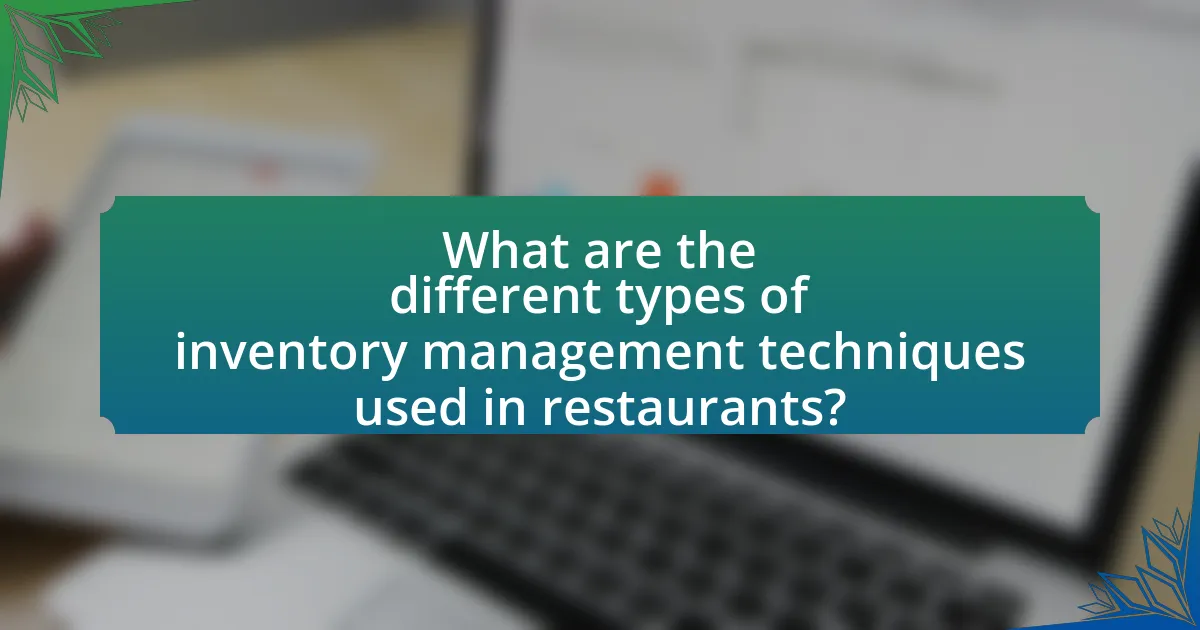The article focuses on inventory management techniques specifically tailored for restaurants, highlighting methods such as inventory tracking systems, FIFO (First In, First Out), par stock levels, and regular inventory audits. It discusses the impact of these techniques on restaurant operations, emphasizing their role in optimizing stock levels, reducing waste, and controlling food costs. Key components of effective inventory management, including accurate tracking, demand forecasting, and supplier management, are outlined, along with the challenges faced by restaurants lacking proper inventory practices. The article also explores the advantages of technology in enhancing inventory management and provides practical tips for optimizing these techniques to improve operational efficiency and customer satisfaction.

What are Inventory Management Techniques for Restaurants?
Inventory management techniques for restaurants include the use of inventory tracking systems, FIFO (First In, First Out) method, par stock levels, and regular inventory audits. Inventory tracking systems, such as software solutions, help restaurants monitor stock levels in real-time, reducing waste and ensuring that ingredients are available when needed. The FIFO method ensures that older stock is used before newer stock, minimizing spoilage and waste. Establishing par stock levels allows restaurants to maintain optimal inventory levels, ensuring they have enough supplies without overstocking. Regular inventory audits help identify discrepancies, track usage patterns, and adjust purchasing strategies accordingly. These techniques collectively enhance efficiency, reduce costs, and improve overall operational effectiveness in restaurant inventory management.
How do these techniques impact restaurant operations?
Inventory management techniques significantly enhance restaurant operations by optimizing stock levels and reducing waste. Effective inventory management allows restaurants to maintain the right amount of ingredients, ensuring that they can meet customer demand without overstocking, which can lead to spoilage. For instance, implementing a just-in-time inventory system can decrease food waste by up to 30%, as it aligns purchasing with actual sales patterns. Additionally, accurate inventory tracking can improve cost control, as restaurants can identify which items are underperforming and adjust their menus accordingly. This data-driven approach not only streamlines operations but also enhances profitability by minimizing unnecessary expenditures.
What are the key components of effective inventory management?
The key components of effective inventory management include accurate tracking, demand forecasting, stock control, and supplier management. Accurate tracking ensures that inventory levels are monitored in real-time, which helps prevent stockouts and overstock situations. Demand forecasting utilizes historical sales data to predict future inventory needs, allowing restaurants to adjust their orders accordingly. Stock control involves implementing systems to manage inventory turnover and minimize waste, which is crucial in the perishable goods sector. Lastly, effective supplier management fosters strong relationships with vendors, ensuring timely deliveries and favorable terms, which are essential for maintaining optimal inventory levels. These components collectively enhance operational efficiency and profitability in restaurant inventory management.
How do inventory techniques influence food cost control?
Inventory techniques significantly influence food cost control by optimizing stock levels and reducing waste. Effective inventory management, such as FIFO (First In, First Out) and JIT (Just In Time), ensures that perishable items are used before they expire, minimizing spoilage and associated costs. For instance, a study by the National Restaurant Association found that restaurants implementing systematic inventory tracking can reduce food waste by up to 30%, directly impacting overall food costs. Additionally, accurate inventory counts help in forecasting demand, allowing restaurants to purchase only what is necessary, further controlling expenses and enhancing profitability.
Why is inventory management crucial for restaurants?
Inventory management is crucial for restaurants because it directly impacts profitability and operational efficiency. Effective inventory management ensures that restaurants maintain optimal stock levels, reducing waste and minimizing costs associated with overstocking or stockouts. According to a study by the National Restaurant Association, proper inventory control can lead to a reduction in food costs by up to 10%, significantly enhancing a restaurant’s bottom line. Additionally, accurate inventory tracking helps in forecasting demand, allowing restaurants to make informed purchasing decisions and improve menu planning. This strategic approach not only enhances customer satisfaction by ensuring availability of popular items but also streamlines operations, ultimately contributing to the restaurant’s success.
What challenges do restaurants face without proper inventory management?
Restaurants face significant challenges without proper inventory management, including food waste, stockouts, and financial losses. Inefficient tracking of inventory can lead to over-ordering, resulting in spoilage and waste; studies indicate that restaurants waste approximately 10% of their food due to poor inventory practices. Additionally, inadequate inventory management can cause stockouts, leading to missed sales opportunities and dissatisfied customers, as 70% of consumers report that they would not return to a restaurant that frequently runs out of menu items. Financially, restaurants may experience increased operational costs and reduced profit margins, as mismanaged inventory can inflate expenses and decrease overall efficiency.
How does effective inventory management enhance customer satisfaction?
Effective inventory management enhances customer satisfaction by ensuring that restaurants consistently have the right products available to meet customer demand. When inventory is managed efficiently, restaurants can minimize stockouts and overstock situations, leading to a reliable dining experience for customers. For instance, a study by the National Restaurant Association found that 70% of customers are likely to return to a restaurant that consistently has their desired menu items available. This reliability fosters customer trust and loyalty, ultimately improving overall satisfaction.

What are the different types of inventory management techniques used in restaurants?
The different types of inventory management techniques used in restaurants include FIFO (First In, First Out), LIFO (Last In, First Out), Just-In-Time (JIT), and ABC analysis. FIFO ensures that older stock is used first, reducing spoilage and waste, while LIFO allows for newer stock to be used first, which can be beneficial in certain pricing scenarios. JIT minimizes inventory levels by ordering supplies only as needed, enhancing cash flow and reducing storage costs. ABC analysis categorizes inventory into three groups (A, B, and C) based on value and turnover rate, allowing restaurants to prioritize management efforts on high-value items. These techniques are widely adopted in the restaurant industry to optimize inventory control, reduce costs, and improve operational efficiency.
How does the FIFO method work in restaurant inventory management?
The FIFO (First In, First Out) method in restaurant inventory management ensures that the oldest stock is used or sold first, minimizing waste and spoilage. This method is crucial for perishable items, as it helps maintain food quality and safety by reducing the likelihood of using expired products. For example, if a restaurant receives a shipment of vegetables, FIFO dictates that the vegetables received first should be used before newer stock. This practice not only enhances operational efficiency but also aligns with food safety regulations, as it helps prevent foodborne illnesses associated with expired ingredients.
What are the advantages of using the FIFO method?
The FIFO (First In, First Out) method offers several advantages in inventory management for restaurants, primarily ensuring that older stock is used before newer stock. This approach minimizes food spoilage and waste, as perishable items are utilized in a timely manner, leading to cost savings. Additionally, FIFO helps maintain product quality and freshness, which is crucial in the food industry, enhancing customer satisfaction. Furthermore, using FIFO can simplify inventory tracking and accounting, as it aligns with the natural flow of goods, making it easier to manage stock levels and reduce discrepancies.
What challenges might arise when implementing FIFO?
Implementing FIFO (First In, First Out) in inventory management can present several challenges, including the need for accurate tracking of inventory dates and potential spoilage of older stock. Accurate tracking is essential because if items are not properly dated, there is a risk that newer stock may be used before older stock, leading to waste. Additionally, perishable items, common in restaurant inventory, may spoil if not rotated correctly, resulting in financial losses. A study by the Food and Agriculture Organization indicates that improper inventory management can lead to up to 30% food waste in restaurants, highlighting the importance of effective FIFO implementation.
What is the role of technology in inventory management for restaurants?
Technology plays a crucial role in inventory management for restaurants by automating processes, enhancing accuracy, and providing real-time data. Automated inventory systems reduce human error, streamline ordering processes, and help track stock levels efficiently. For instance, point-of-sale (POS) systems integrated with inventory management software can automatically update inventory counts as sales occur, ensuring that restaurant operators have accurate information on stock availability. According to a study by the National Restaurant Association, 70% of restaurants that implemented technology in inventory management reported improved efficiency and reduced food waste, demonstrating the effectiveness of these technological solutions in optimizing inventory control.
How can restaurant management software improve inventory tracking?
Restaurant management software can improve inventory tracking by automating the monitoring and management of stock levels in real-time. This software provides features such as barcode scanning, which allows for quick updates to inventory counts as items are sold or received, reducing human error. Additionally, it generates detailed reports on inventory usage and trends, enabling restaurant managers to make informed purchasing decisions and minimize waste. According to a study by the National Restaurant Association, effective inventory management can reduce food costs by up to 10%, demonstrating the financial benefits of utilizing such software.
What features should restaurant inventory management software include?
Restaurant inventory management software should include features such as real-time inventory tracking, automated stock alerts, recipe management, supplier management, and reporting and analytics. Real-time inventory tracking allows restaurants to monitor stock levels continuously, reducing the risk of overstocking or stockouts. Automated stock alerts notify managers when inventory reaches predefined thresholds, ensuring timely reordering. Recipe management enables precise ingredient tracking and cost control, while supplier management streamlines procurement processes. Reporting and analytics provide insights into inventory turnover and food costs, helping restaurants make informed decisions. These features collectively enhance operational efficiency and profitability in restaurant inventory management.

How can restaurants optimize their inventory management techniques?
Restaurants can optimize their inventory management techniques by implementing a combination of technology, data analysis, and best practices. Utilizing inventory management software allows restaurants to track stock levels in real-time, reducing waste and ensuring that popular items are always available. Data analysis helps identify trends in customer preferences and seasonal fluctuations, enabling more accurate forecasting and ordering. Additionally, adopting a first-in, first-out (FIFO) approach ensures older stock is used first, minimizing spoilage. According to a study by the National Restaurant Association, effective inventory management can reduce food costs by up to 10%, highlighting the financial benefits of these techniques.
What best practices should restaurants follow for effective inventory management?
Restaurants should implement regular inventory audits to ensure accurate stock levels and minimize waste. Conducting these audits weekly or bi-weekly allows restaurants to track usage patterns and identify discrepancies between recorded and actual inventory. Additionally, utilizing inventory management software can streamline the tracking process, providing real-time data on stock levels and helping to forecast future needs based on sales trends. Research indicates that restaurants using such software can reduce food costs by up to 10% through better inventory control. Establishing par levels for each item ensures that restaurants maintain optimal stock without over-ordering, further enhancing efficiency and reducing spoilage.
How can regular inventory audits improve accuracy?
Regular inventory audits improve accuracy by systematically verifying stock levels against recorded data. This process identifies discrepancies, such as overstocking or stockouts, which can lead to financial losses. According to a study by the National Restaurant Association, restaurants that conduct regular inventory audits can reduce inventory discrepancies by up to 30%, leading to more accurate financial reporting and better decision-making. By maintaining accurate inventory records, restaurants can optimize their purchasing strategies, minimize waste, and enhance overall operational efficiency.
What strategies can be implemented to reduce food waste?
Implementing strategies such as accurate inventory tracking, portion control, and menu optimization can significantly reduce food waste in restaurants. Accurate inventory tracking allows restaurants to monitor stock levels and expiration dates, ensuring that ingredients are used before they spoil. Portion control helps in serving appropriate amounts to customers, minimizing leftovers. Menu optimization involves designing dishes that utilize similar ingredients, reducing the likelihood of unused stock. According to the Food Waste Reduction Toolkit by the U.S. Environmental Protection Agency, effective inventory management can lead to a reduction of food waste by up to 30%.
What common mistakes should restaurants avoid in inventory management?
Restaurants should avoid over-ordering inventory, as it leads to increased waste and higher costs. Excess inventory can spoil, especially perishable items, resulting in financial losses. Additionally, neglecting regular inventory audits can cause discrepancies between actual stock and recorded amounts, leading to stockouts or overstock situations. Failing to implement a first-in, first-out (FIFO) system can also result in older stock being overlooked, increasing spoilage rates. Lastly, not utilizing inventory management software can hinder accurate tracking and forecasting, making it difficult to make informed purchasing decisions.
How can overstocking negatively impact restaurant operations?
Overstocking negatively impacts restaurant operations by increasing costs and reducing efficiency. When a restaurant holds excessive inventory, it incurs higher storage costs, potential spoilage, and waste, which can lead to financial losses. For instance, the National Restaurant Association reports that food waste can account for up to 10% of a restaurant’s total operating costs. Additionally, overstocking can complicate inventory management, making it difficult to track stock levels accurately and leading to stockouts of essential items. This inefficiency can disrupt service and diminish customer satisfaction, ultimately harming the restaurant’s reputation and profitability.
What are the risks of understocking inventory?
Understocking inventory poses significant risks, including lost sales, decreased customer satisfaction, and potential damage to brand reputation. When inventory levels are insufficient, restaurants may be unable to fulfill customer orders, leading to immediate revenue loss. According to a study by the National Restaurant Association, 70% of customers are likely to leave a restaurant if their desired menu item is unavailable, highlighting the direct impact on customer retention and satisfaction. Additionally, frequent stockouts can result in customers seeking alternatives, which can permanently shift their loyalty away from the restaurant. This underscores the importance of maintaining optimal inventory levels to ensure consistent service and uphold a positive brand image.
What practical tips can enhance inventory management in restaurants?
Implementing a robust inventory management system can significantly enhance inventory management in restaurants. Utilizing software solutions allows for real-time tracking of stock levels, which helps prevent overstocking and stockouts. Regularly conducting physical inventory counts ensures accuracy in recorded stock levels, while establishing par levels for each item aids in maintaining optimal inventory levels. Additionally, training staff on proper inventory handling and storage techniques minimizes waste and spoilage. According to a study by the National Restaurant Association, effective inventory management can reduce food costs by up to 10%, demonstrating the financial benefits of these practices.




